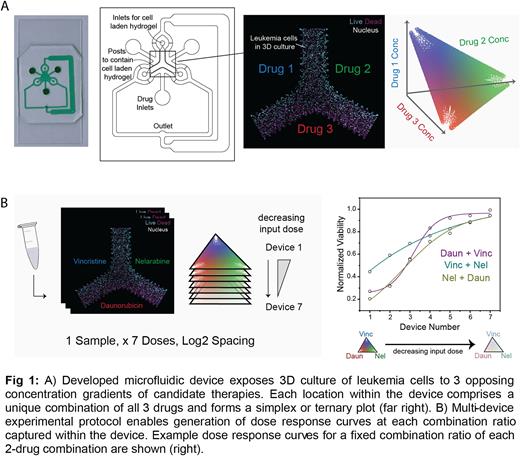Abstract
Treatment of pediatric acute lymphoblastic leukemia (ALL) has seen dramatic improvements over the last several decades, leading to overall survival rates of over 85%. However, for patients with relapsed/refractory disease, achieving complete remission remains extremely challenging. Improving treatment outcomes for these patients will require increasingly personalized treatment strategies that make use of functional screens in addition to molecular profiling technologies for treatment selection. Given the past success of combination chemotherapy in cancer treatment and recent promise for newly developed targeted agents, functional assays that are able to evaluate patient response to combinations of therapies will likely be most effective in identifying clinically actionable treatment protocols. Moreover, assays that can achieve this with minimal patient sample and reduced experimental workload will have the greatest potential for clinical translation and integration into clinical workflows.
To that end, this work aims to develop a microfluidic assay to directly test candidate combinations of therapeutics in patient derived ALL cells. We aim for this to serve as a more effective way to screen for drug combination response and higher order interactions relative to standard wellplate formats. Once validated, this assay can be used to identify biomarkers of response to standard and experimental combination regimens in pediatric ALL, and ultimately, could be used to prospectively guide therapy in newly diagnosed patients.
The developed device achieves this by enabling simultaneous exposure to 3 superimposed small molecule drug gradients across a 3D culture of leukemia cells such that each location in the device comprises a unique combination of all 3 drugs within a simplex (Fig 1A). Single cell drug concentration exposure is determined from experimentally validated steady state computational fluid dynamics (CFD) model predictions, and single cell viability is analyzed via Calcein (live), PI (dead) and Hoechst (nuclear) staining following 48 hours of treatment.
Using this system, we then develop a novel experimental and computational framework for evaluating drug combination efficacy and synergy across the full range of combination ratios captured in our device. Specifically, we evaluate response across multiple devices at optimally spaced dose levels, increasing coverage of the 3-drug combination space and allowing for custom implementation of established synergy models. This enables synergy assessment in a continuous gradient of drug combination ratios, as opposed to the discrete combination ratios commonly evaluated in standard assays, and may further improve detection of drug synergy and identification of the most potent and efficacious combination ratios.
To demonstrate this, we analyze response to a combination of daunorubicin, vincristine, and nelarabine in Jurkats, a T-ALL cell line, across 7 different devices at 7 different dose levels (Fig 1B). We quantify viability as a function of concentration across each device and each dose level, and generate dose response curves at distinct zones within the device. Specifically, we generate dose response curves in zones dominated by daunorubicin, vincristine, and nelarabine alone and find half maximal effective concentration values (EC50 values) similar to those reported in literature. We further evaluate response at varying ratios of each 2-drug combination, and generate dose response curves as shown in Fig 1B. Analyzing the 2-drug combination dose responses relative to single-drug dose responses allows for quantification of 2-drug combination synergy based on Loewe and DiaMOND synergy models, and future work will extend our developed method to analyze emergent 3-drug combination synergy.
Disclosures
Kemp:Parthenon Therapeutics: Membership on an entity's Board of Directors or advisory committees.
Author notes
Asterisk with author names denotes non-ASH members.


This feature is available to Subscribers Only
Sign In or Create an Account Close Modal